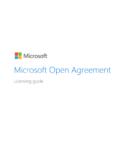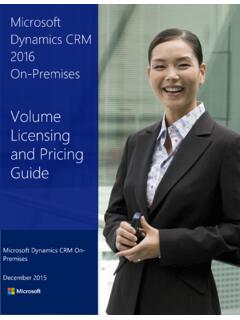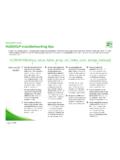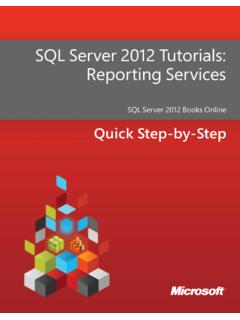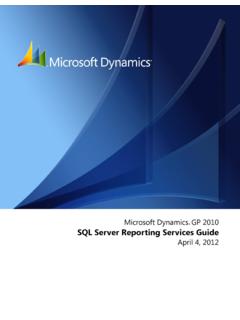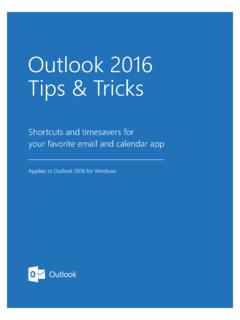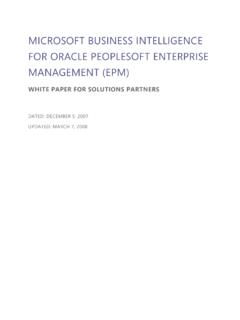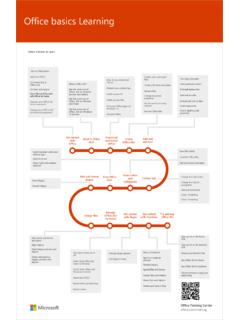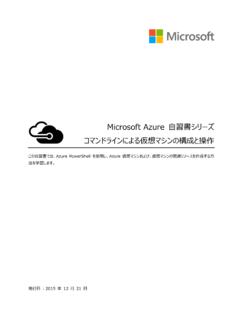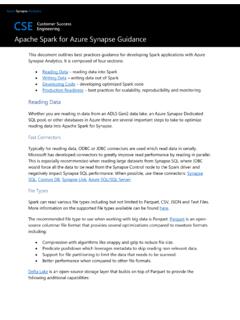Transcription of Microsoft Azure IoT Reference Architecture Version 2.1 9 ...
1 Microsoft Azure IoT Reference Architecture Version 1. Classified as Microsoft Confidential Contents 1. Overview .. 3. Architecture Overview .. 3. Core 4. Optional Subsystems .. 5. Cross-Cutting IoT application needs .. 6. 2. Foundational principles and concepts .. 8. Principles .. 8. Data concepts .. 8. 3. Architecture Subsystem Details .. 11. Devices, Device Connectivity, Field Gateway (Edge Device), Cloud Gateway .. 11. Device identity store .. 16. Topology and entity store .. 17. Device provisioning .. 20. storage .. 21. Data flow and stream processing .. 27. Solution User Interface .. 32. Business System Integration and Backend Application Processing .. 34. Machine Learning (At-rest data analytics).
2 37. 4. Solution design considerations .. 37. 5 Appendix .. 57. The information herein is for informational purposes only and represents the current view of Microsoft Corporation as of the date of this publication. Because Microsoft must respond to changing market conditions, it should not be interpreted to be a commitment on the part of Microsoft , and Microsoft cannot guarantee the accuracy of any information provided after the date of this presentation. Microsoft MAKES NO WARRANTIES, EXPRESS, IMPLIED OR. STATUTORY, AS TO THE INFORMATION IN THIS PRESENTATION. 2018 Microsoft . All rights reserved. This document is for informational purposes only. Microsoft makes no warranties, express or implied, with respect to the information presented here 2.
3 1. Overview Connected sensors, devices, and intelligent operations can transform businesses and enable new growth opportunities with a comprehensive set of Microsoft Azure Internet of Things (IoT) services. The purpose of the document is to provide an overview of the recommended Architecture and implementation technology choices for how to build Azure IoT applications. This Architecture describes terminology, technology principles, common configuration environments, and composition of Azure IoT services. The primary targets of this document are architects, system designers, developers, and other IoT technical decision makers. IoT applications can be described as Things (or devices), sending data or events that are used to generate Insights, which are used to generate Actions to help improve a business or process.
4 An example is an engine (a thing), sending pressure and temperature data used to evaluate whether the engine is performing as expected (an insight), which is used to proactively prioritize the maintenance schedule for the engine (an action). This document focuses on how to build an IoT application, however it is important to be cognizant of the end goal of the Architecture : taking action on business insights we find through gathering data from assets. The document contains five sections: 1) an introduction, and 2) an overview containing the overall recommended Architecture for IoT solutions (divided into subsystems), a brief introduction to IoT application subsystems, default technology recommendations per subsystem, and a discussion of cross-cutting concerns for IoT applications, 3).
5 Foundational concepts and principles- concepts and principles central to building scalable IoT applications are described in this section, 4) subsystem details- for each subsystem a subsection is dedicated to describing the subsystem responsibilities and technology alternatives for implementation, and 5) Solution design considerations a section describing implementation considerations of the Architecture for solutions and industry verticals. This document is a living document and will be updated as the cloud and technology landscape evolve. The document will track technology trends and provide up to date recommendations for Azure IoT application architectures and technology best practices . Every organization has unique skills and experience and every IoT application has unique needs and considerations.
6 The Reference Architecture and technology choices recommended in this document should be modified as needed for each. Technology recommendations per subsystem were generated using consistent criteria. Some criteria are common across all subsystems and technology alternatives; security, simplicity, performance, scale, and cost are critical, no matter the subsystem or technology. Some criteria are unique to a particular subsystem; query capabilities for warm storage solutions. The criteria used to evaluate technical recommendations are described in the subsystems detail section. Architecture Overview The Architecture we recommend for IoT applications is cloud native, microservice, and serverless based.
7 The different subsystems of an IoT application should be built as discrete services that are independently deployable, and able to 3. scale independently. These attributes enable greater scale, more flexibility in updating individual subsystems, and provide the flexibility to choose appropriate technology on a per subsystem basis. It is critical to have the ability to monitor individual subsystems as well as the IoT application as a whole. We recommend subsystems communicate over REST/HTTPS using JSON (as it is human readable) though binary protocols should be used for high performance needs. The Architecture also supports a hybrid cloud and edge compute strategy; some data processing is expected to happen on premise.
8 We recommend use of an orchestrator ( Azure Managed Kubernetes or Service Fabric) to scale individual subsystems horizontally or PaaS services ( Azure App Services) that offer built-in horizontal scale capabilities. Core Subsystems At the core an IoT application consists of the following subsystems: 1) devices (and/or on premise edge gateways) that have the ability to securely register with the cloud, and connectivity options for sending and receiving data with the cloud, 2) a cloud gateway service, or hub, to securely accept that data and provide device management capabilities, 3). stream processors that consume that data, integrate with business processes, and place the data into storage , and 4) a user interface to visualize telemetry data and facilitate device management.
9 Following, these subsystems are briefly described with prescriptive technology recommendations. Sections covering these subsystems in depth are in section 4. of this document. The Cloud Gateway provides a cloud hub for secure connectivity, telemetry and event ingestion and device management (including command and control) capabilities. We recommend using the Azure IoT Hub service as the cloud gateway. The IoT Hub offers built-in secure connectivity, telemetry and event ingestion, and bi-directional communication with devices including device management with command and control capabilities. In addition, the IoT Hub offers an entity store that can be used to store device metadata. 4. For registering and connecting large sets of Devices we recommend using the Azure IoT Hub Device Provisioning Service (DPS).
10 DPS allows assignment and registration of devices to specific Azure IoT Hub endpoints at scale. We recommend use of the Azure IoT Hub SDKs to enable secure device connectivity and sending telemetry data to the cloud. Stream processing processes large streams of data records and evaluates rules for those streams. For stream processing we recommend using Azure Stream Analytics for IoT applications that require complex rule processing at scale. For simple rules processing we recommend Azure IoT Hub Routes used with Azure Functions. Business process integration facilitates executing actions based on insights garnered from device telemetry data during stream processing. Integration could include storage of informational messages, alarms, sending email or SMS, integration with CRM, and more.
